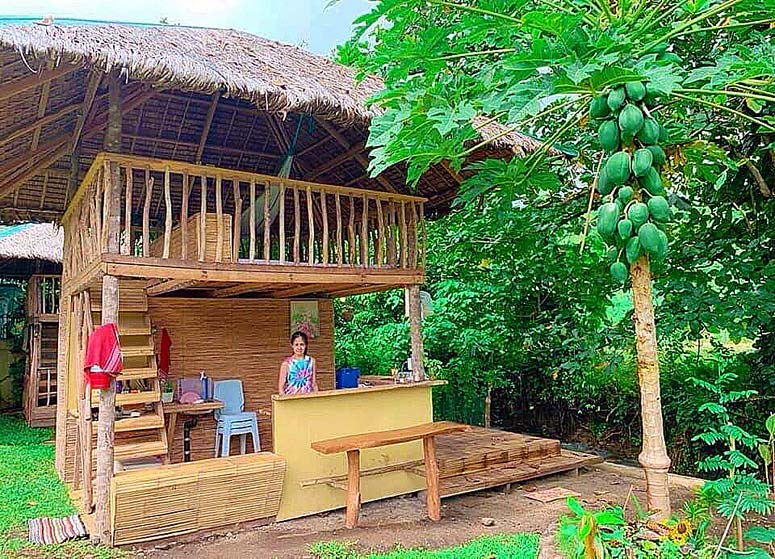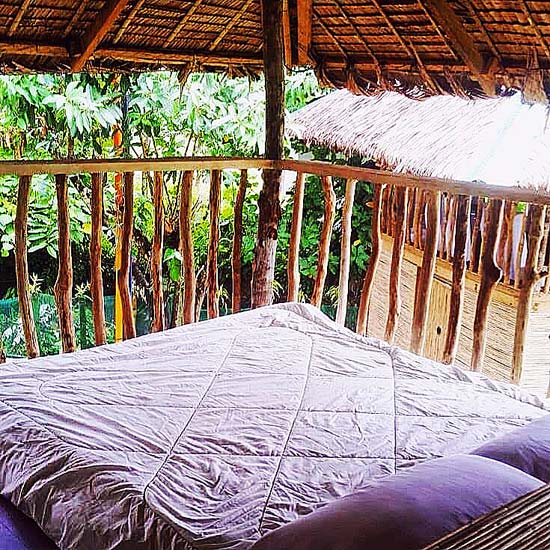“It gives credence indeed that whether in the lowlands or highlands, the bahay kubo endures as the most successful archetype for Philippine architecture.” —Augusto Villalon, Lugar: Essays on Philippine Heritage and Architecture
Talking about the nipa hut or bahay kubo is like talking about our ancestors. Too bad I can’t travel back to 1,400 years ago in the Cordilleras to talk to the highlanders who built one-room, high-altitude versions of the lowland nipa huts which also functioned as their granaries.
Instead of going back in time, it’s easier to talk to Kristine Garcia, designer and owner of Beach House Emporium located in Real, Quezon. I can’t help but be amazed with the parallelism of this interview with a book by Augusto Villalon that I used as reference for this piece. To get the point across, here’s my conversation with Garcia whisking in quotes from that book on Philippine architecture.
Points & Perspectives (PP): Can you share your experience while designing Beach House Emporium? What is the purpose of the space and what design references did you use, if any?

Kristine Garcia (KG): Designing Beach House Emporium started with a year-long obsession with detailed plans for a bed and breakfast thing. My design focused on achieving a space that is well-ventilated where movement of people is easy and traffic flow is light. It had five rooms as in boutique accommodations, a cafe to run from sunrise to sunset and a pool deck for private use. What happened instead was a total redesigning when my bill of materials came. It required me to appropriate a budget of over half a million pesos for louver enclosures and openings alone.

I stood as foreman and designer for this project and I put together a completely different plan as I was building an outhouse to serve as my barracks. Nonetheless, the place would still be a tropical venue that promotes a natural way of life, this time leaning on a provincial feel over a modern touch. We toiled the land and created a garden around my outhouse and three more cottages in similar fashion, al fresco style: two-story unit each with its own shower, kitchen and sitting rooms and a sleeping area upstairs.
PP: Was it easy to source for materials and skilled laborers? What were the challenges you faced during construction?
KG: It was relatively easy to source the local materials. I utilized hardwood, coco lumber, bamboo, tanlak (tubular bamboo sticks commonly used to make blinds) and nipa. I even sourced out grass and plants for the garden. I previously designed a hotel right across my property and gave me the advantage of making acquaintance with the local labor force of this beach town. The challenge came with the distance I had to drive to Real from Antipolo where I am based.

“I have made the point that builders must learn the local language—if not, they will be outsiders, architectural tourists.” – Witold Rybczynski, The Most Beautiful House in the World (as cited in Lugar: Essays on Philippine Heritage and Architecture).
PP: Before or during construction, were your expectations properly set in terms of how durable the structure was going to be?
KG: I’ve realized the outstanding and durable qualities of light-material structures during my past opportunity to design an island spa. To me, the integrity of a building, whether big or small, doesn’t only depend on its foundation and frame, but also on its form, function, location and local weather.
“Designed as an impermanent structure, it was always at the mercy of the severe and demanding tropical environment. However, it was a structure with many lives.” —Augusto Villalon, Lugar: Essays on Philippine Heritage and Architecture.
PP: Did any of the structures experience any damage/s during any of the typhoons?
KG: On very bad occasions such as a storm signal with strong winds and heavy rains, the cottages were drenched in and out but they thoroughly dried as soon as the sun appeared. Moisture evaporates quickly because of the natural breeze. The strong mahogany posts don’t allow movement nor disturbance of structure. The posts are positioned in ways that cooperate with wind direction, keeping the property away from disaster.
“Therefore, Filipino architecture has always responded environmentally, technologically, spatially, and culturally to the lifestyle that existed in the country during each different moment in history.” —Augusto Villalon, Lugar: Essays on Philippine Heritage and Architecture.
PP: Aside from what you shared, is there anything else you want us to know about Beach House Emporium?
KG: Beach House Emporium is a place to glamp where you have all the fresh, clean and quiet to yourselves and your pets even. It offers time to both rest and be present with nature. A surf beach is just across and short trails to waterfalls are nearby. It’s about 130 kilometers away from Metro Manila. No toll gates, only greens.
* * *
It’s confounding to be reminded that most of the materials and even the building techniques used over a thousand years ago to build those kubos are the same today whether on shallow waters down South or on rice terraces way up North. The bahay kubo is truly a static Asian artefact that will will always be relevant yesterday, today and tomorrow.
For inquiries, visit @realbeachhouseemporium on Facebook or Instagram.
(To be continued)
Talking about the nipa hut or bahay kubo is like talking about our ancestors. Too bad I can’t travel back to 1,400 years ago in the Cordilleras to talk to the highlanders who built one-room, high-altitude versions of the lowland nipa huts which also functioned as their granaries.
Instead of going back in time, it’s easier to talk to Kristine Garcia, designer and owner of Beach House Emporium located in Real, Quezon. I can’t help but be amazed with the parallelism of this interview with a book by Augusto Villalon that I used as reference for this piece. To get the point across, here’s my conversation with Garcia whisking in quotes from that book on Philippine architecture.
Points & Perspectives (PP): Can you share your experience while designing Beach House Emporium? What is the purpose of the space and what design references did you use, if any?
Kristine Garcia (KG): Designing Beach House Emporium started with a year-long obsession with detailed plans for a bed and breakfast thing. My design focused on achieving a space that is well-ventilated where movement of people is easy and traffic flow is light. It had five rooms as in boutique accommodations, a cafe to run from sunrise to sunset and a pool deck for private use. What happened instead was a total redesigning when my bill of materials came. It required me to appropriate a budget of over half a million pesos for louver enclosures and openings alone.
I stood as foreman and designer for this project and I put together a completely different plan as I was building an outhouse to serve as my barracks. Nonetheless, the place would still be a tropical venue that promotes a natural way of life, this time leaning on a provincial feel over a modern touch. We toiled the land and created a garden around my outhouse and three more cottages in similar fashion, al fresco style: two-story unit each with its own shower, kitchen and sitting rooms and a sleeping area upstairs.
PP: Was it easy to source for materials and skilled laborers? What were the challenges you faced during construction?
KG: It was relatively easy to source the local materials. I utilized hardwood, coco lumber, bamboo, tanlak (tubular bamboo sticks commonly used to make blinds) and nipa. I even sourced out grass and plants for the garden. I previously designed a hotel right across my property and gave me the advantage of making acquaintance with the local labor force of this beach town. The challenge came with the distance I had to drive to Real from Antipolo where I am based.
“I have made the point that builders must learn the local language—if not, they will be outsiders, architectural tourists.” – Witold Rybczynski, The Most Beautiful House in the World (as cited in Lugar: Essays on Philippine Heritage and Architecture).
PP: Before or during construction, were your expectations properly set in terms of how durable the structure was going to be?
KG: I’ve realized the outstanding and durable qualities of light-material structures during my past opportunity to design an island spa. To me, the integrity of a building, whether big or small, doesn’t only depend on its foundation and frame, but also on its form, function, location and local weather.
“Designed as an impermanent structure, it was always at the mercy of the severe and demanding tropical environment. However, it was a structure with many lives.” —Augusto Villalon, Lugar: Essays on Philippine Heritage and Architecture.
PP: Did any of the structures experience any damage/s during any of the typhoons?
KG: On very bad occasions such as a storm signal with strong winds and heavy rains, the cottages were drenched in and out but they thoroughly dried as soon as the sun appeared. Moisture evaporates quickly because of the natural breeze. The strong mahogany posts don’t allow movement nor disturbance of structure. The posts are positioned in ways that cooperate with wind direction, keeping the property away from disaster.
“Therefore, Filipino architecture has always responded environmentally, technologically, spatially, and culturally to the lifestyle that existed in the country during each different moment in history.” —Augusto Villalon, Lugar: Essays on Philippine Heritage and Architecture.
PP: Aside from what you shared, is there anything else you want us to know about Beach House Emporium?
KG: Beach House Emporium is a place to glamp where you have all the fresh, clean and quiet to yourselves and your pets even. It offers time to both rest and be present with nature. A surf beach is just across and short trails to waterfalls are nearby. It’s about 130 kilometers away from Metro Manila. No toll gates, only greens.
* * *
It’s confounding to be reminded that most of the materials and even the building techniques used over a thousand years ago to build those kubos are the same today whether on shallow waters down South or on rice terraces way up North. The bahay kubo is truly a static Asian artefact that will will always be relevant yesterday, today and tomorrow.
For inquiries, visit @realbeachhouseemporium on Facebook or Instagram.
(To be continued)
